Railroad Lanterns
Of the various types of collectibles that reflect the great age of
American railroads, lanterns are among the most popular. Their appeal
is due to a variety of reasons. They remind people of era when trains
were run by steam power and when most facets of personal and community
life had some connection with the railroad. For some collectors, lanterns
provide a tangible connection with working railroaders who were part
of this now vanished era and who used lanterns daily as a tool of the
trade. 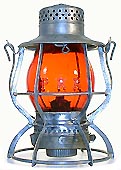 Still
other collectors appreciate the design of railroad lanterns whereby
metal and glass are combined in an industrial artifact that was designed
purely for function but which still had esthetic appeal. For these and
other reasons, railroad lanterns are enthusiastically collected by growing
number of people in the the hobby. Still
other collectors appreciate the design of railroad lanterns whereby
metal and glass are combined in an industrial artifact that was designed
purely for function but which still had esthetic appeal. For these and
other reasons, railroad lanterns are enthusiastically collected by growing
number of people in the the hobby.
Over the few decades, a common approach to classifying lanterns has
gradually evolved among collectors. The terms used here are sometimes
quite different than what is found in original manufacturers' catalogs
and railroad rule books. However, such terms serve the purpose of allowing
collectors to have a common understanding of what everybody's talking
about.
First, collectors usually make a distinction between lanterns and lamps.
A Lantern is essentially a metal "cage" containing a transparent
or translucent globe that protects an interior light source. This definition
applies to lanterns using combustible fuel rather than electric lanterns
which usually have exposed light bulbs instead of a globe. Lamps are
essentially a solid metal cylinder with one or more lenses used to transmit
light from an interior light source. One type of lantern, the Inspector's
Lantern, does have a substantial metal body, however, it also has a
globe which, for purposes here, places it in the lantern category.
There are perhaps five basic categories that collectors use to classify
railroad lanterns. These are: Fixed Globe Lanterns, Tall Globe Lanterns,
Short Globe Lanterns, Conductors' Lanterns, and Inspectors Lanterns.
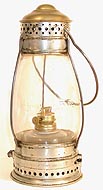 Fixed
Globe Lanterns. The earliest type of railroad lantern was
the fixed-globe lantern, so called because the globe was cemented
in a frame and could not be readily removed. This style of lantern
was most popular in the decades that spanned the Civil War. It's not
possible to precisely pinpoint the date when fixed-globe lanterns
were replaced by the removable-globe variety, although evidence suggests
that the latter was introduced immediately after the Civil War. However
like most innovations, removable-globe lanterns were not instantly
adopted by the industry, and it appears that fixed-globe Lanterns
continued to be manufactured for a decade or two after the Civil War. Fixed
Globe Lanterns. The earliest type of railroad lantern was
the fixed-globe lantern, so called because the globe was cemented
in a frame and could not be readily removed. This style of lantern
was most popular in the decades that spanned the Civil War. It's not
possible to precisely pinpoint the date when fixed-globe lanterns
were replaced by the removable-globe variety, although evidence suggests
that the latter was introduced immediately after the Civil War. However
like most innovations, removable-globe lanterns were not instantly
adopted by the industry, and it appears that fixed-globe Lanterns
continued to be manufactured for a decade or two after the Civil War.
The heyday of the fixed-globe lantern especially coincided with the
era of railroad expansion in the Northeastern United States. The first
transcontinental railroad line was not completed until 1869; however,
railroad building in the Northeast had already been underway for several
decades. Therefore, it is not surprising that most of the markings that
are found on fixed-globe lanterns reflect lines from this part of the
country. There were many small manufacturers of railroad lanterns at
the time -- standardization in the industry had yet to occur -- so there
is a wide variety of styles and features that can be found in surviving
fixed-globe lanterns. Because of this and the regional quality of such
lanterns, collecting fixed-globe lanterns tends to be a specialized
part of the hobby. Above Right: A C.T. Ham fixed-globe
lantern with a clear cast globe marked B.& A. R.R." for the
Boston & Albany Railroad.
Tall-Globe Lanterns. Tall-globe lanterns, also called "Tall
Lanterns", are distinguished by removable globes of 5 and 3/8 inches
to 6 inches in height. The removable nature of such globes was a real
improvement over fixed-globe models for obvious reasons of convenience.
Also the size of such globes was well suited to the combustion of the
fuel that was gaining favor for lantern use - signal oil. According
to Cunningham, the production of the first removable globe lantern is
credited to William Westlake, who produced a lantern with such a globe
in 1865. However, the real popularity of tall lanterns spanned a period
from the 1870's to World War I. During the latter event, national priorities
prompted railroads to switch to a different type of lantern fuel --
kerosene -- which led to the development of short-globe lantern models.
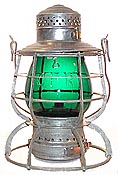 Tall
lanterns are particularly sought after by collectors because of their
size, design and variety. Many manufacturers produced such lanterns,
representing a wide range of ornateness and technological innovation.
Also, since tall lanterns were produced during the most expansive period
of U.S. railroading, they often are marked for Tall
lanterns are particularly sought after by collectors because of their
size, design and variety. Many manufacturers produced such lanterns,
representing a wide range of ornateness and technological innovation.
Also, since tall lanterns were produced during the most expansive period
of U.S. railroading, they often are marked for 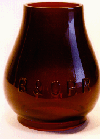 railroads
that are long gone and that have special historical significance. Toward
the end of tall lantern production, the number of companies in the industry
narrowed down to a fairly small number, and a certain level of standardization
became evident. Nevertheless, the number of variations even within certain
model types was large, and tall lanterns are probably the most widely
sought-after type of railroad lantern. Above Right: A
R.R. Signal Lamp & Lantern tall-globe lantern marked "C.P.
Ry" with a green cast globe marked "CPR" for the Canadian
Pacific Railway. Above Left: A 5 3/8" red cast
globe with an extended base marked "B.&.O. R.R." for the
Baltimore & Ohio Railroad. railroads
that are long gone and that have special historical significance. Toward
the end of tall lantern production, the number of companies in the industry
narrowed down to a fairly small number, and a certain level of standardization
became evident. Nevertheless, the number of variations even within certain
model types was large, and tall lanterns are probably the most widely
sought-after type of railroad lantern. Above Right: A
R.R. Signal Lamp & Lantern tall-globe lantern marked "C.P.
Ry" with a green cast globe marked "CPR" for the Canadian
Pacific Railway. Above Left: A 5 3/8" red cast
globe with an extended base marked "B.&.O. R.R." for the
Baltimore & Ohio Railroad.
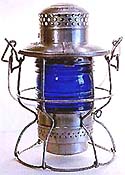 Short-Globe
Lanterns. Short-globe lanterns or "short lanterns" came
into production after World War I and continued to be made through
the 1960's or early 1970's. Actually, some still continue to be made
for specialty purposes but their regular use in railroad service can
be considered effectively over. They are usually characterized by
globes that are 3 1/4 to 4 1/2 inches high as compared to globes from
tall lanterns that are usually 5 3/8 to 6 inches high. Short lanterns
succeeded tall lanterns because railroads switched to kerosene as
lantern fuel after World War One, and the smaller burning chamber
of the shorter globe was especially suited to this type of fuel. The
lighter weight and better portability of the short lantern were also
likely factors in its acceptance. Short-Globe
Lanterns. Short-globe lanterns or "short lanterns" came
into production after World War I and continued to be made through
the 1960's or early 1970's. Actually, some still continue to be made
for specialty purposes but their regular use in railroad service can
be considered effectively over. They are usually characterized by
globes that are 3 1/4 to 4 1/2 inches high as compared to globes from
tall lanterns that are usually 5 3/8 to 6 inches high. Short lanterns
succeeded tall lanterns because railroads switched to kerosene as
lantern fuel after World War One, and the smaller burning chamber
of the shorter globe was especially suited to this type of fuel. The
lighter weight and better portability of the short lantern were also
likely factors in its acceptance.
Among collectors, short lanterns are considered less desirable, mostly
because as a class they are (relatively) newer than tall-globe lanterns.
Also they are a lot more common. However, the irony here is that the
era of the short lantern more closely corresponds to the "golden
age" of American railroading when the most impressive developments
in steam power were taking place and when railroads truly permeated
most aspects of American life. Thus, as reminders of this era, the short
lantern has perhaps more to claim than the more collectible tall-globe
variety.
 The
major U.S. manufacturers who made short lanterns were Adams & Westlake,
Armspear Manufacturing, R.E. Dietz , Lovell-Dressel, and Handlan. Dietz
also made a popular series of lanterns called the "Vesta",
most of which took a special 4 1/4 inch globe that was an inch taller
than a true "short globe." Vesta's are usually classified
as short globe lanterns. Above Right: A "Kero" short-globe
lantern made by Adams & Westlake with a blue fresnel globe; Left: A
3 1/2" red globe. The
major U.S. manufacturers who made short lanterns were Adams & Westlake,
Armspear Manufacturing, R.E. Dietz , Lovell-Dressel, and Handlan. Dietz
also made a popular series of lanterns called the "Vesta",
most of which took a special 4 1/4 inch globe that was an inch taller
than a true "short globe." Vesta's are usually classified
as short globe lanterns. Above Right: A "Kero" short-globe
lantern made by Adams & Westlake with a blue fresnel globe; Left: A
3 1/2" red globe.
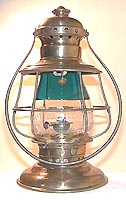 Conductors'
Lanterns. A special style of lantern used by conductors was
the "conductors' lantern" also called a "presentation
lantern". The latter phrase .reflects the fact that this style
of lantern was sometimes used for award purposes with ornate and elaborate
markings honoring a specific individual. As a category, conductors'
lanterns are generally fancier than the ordinary brakemans' lanterns
and are often found with nickel or brass plating, more delicate designs,
and/or globes with ornamental lettering. This difference in quality
reflected both the status of the conductor as the highest authority
on a passenger train (higher than the engineer) and the fact that
his lantern was likely to be seen by the traveling public. A wide
variety of conductors' lanterns were produced by different lantern
manufacturers, and many of these took special globes that could be
used only in such lanterns. Today, conductors' lanterns tend to be
an especially valued collectible (translation: $$$!). Above
Right: A brass conductors' lantern manufactured by the Steam
Gauge & Lantern Company from the collection of Bill Kajdzik. Conductors'
Lanterns. A special style of lantern used by conductors was
the "conductors' lantern" also called a "presentation
lantern". The latter phrase .reflects the fact that this style
of lantern was sometimes used for award purposes with ornate and elaborate
markings honoring a specific individual. As a category, conductors'
lanterns are generally fancier than the ordinary brakemans' lanterns
and are often found with nickel or brass plating, more delicate designs,
and/or globes with ornamental lettering. This difference in quality
reflected both the status of the conductor as the highest authority
on a passenger train (higher than the engineer) and the fact that
his lantern was likely to be seen by the traveling public. A wide
variety of conductors' lanterns were produced by different lantern
manufacturers, and many of these took special globes that could be
used only in such lanterns. Today, conductors' lanterns tend to be
an especially valued collectible (translation: $$$!). Above
Right: A brass conductors' lantern manufactured by the Steam
Gauge & Lantern Company from the collection of Bill Kajdzik.
 Inspector's
Lanterns. Inspector's lanterns were characterized by a unique
but utilitarian design suited to examining rolling stock. They were
typically constructed of sheet metal with a reflecting surface made
of metal or glass for focusing light in one direction. However, the
flame was enclosed in a globe, so we can reasonably classify them
as a lantern. Inspector's lanterns came in a couple of different sizes
but did not vary all that much in basic appearance. Left: An
Inspector's lantern made by Dietz and marked "B.R.& P. Ry" for
the Buffalo, Rochester & Pittsburgh Railway. Inspector's
Lanterns. Inspector's lanterns were characterized by a unique
but utilitarian design suited to examining rolling stock. They were
typically constructed of sheet metal with a reflecting surface made
of metal or glass for focusing light in one direction. However, the
flame was enclosed in a globe, so we can reasonably classify them
as a lantern. Inspector's lanterns came in a couple of different sizes
but did not vary all that much in basic appearance. Left: An
Inspector's lantern made by Dietz and marked "B.R.& P. Ry" for
the Buffalo, Rochester & Pittsburgh Railway.
Notes: Information sources are Barrett and Cunningham. |